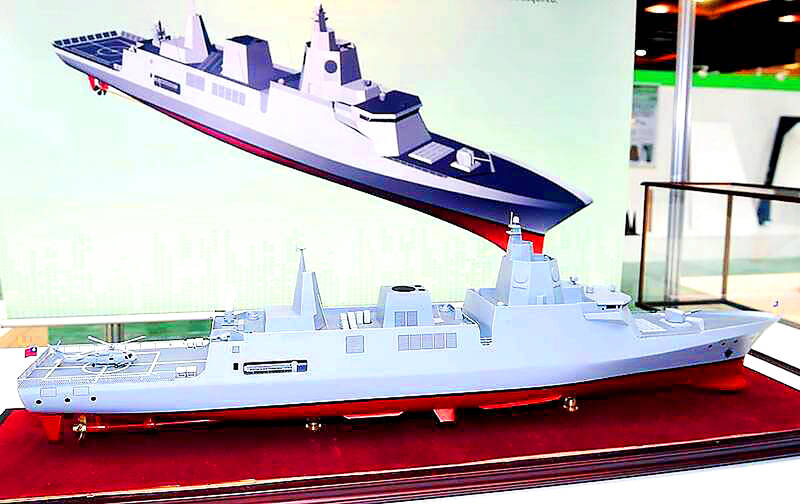The navy has resumed work on developing a new 6,000-tonne guided missile frigate equipped with a US-made radar system, a source said on Saturday.
The project had been halted, but the military has identified a need for a new generation of guided missile frigates equipped with active phased array radars to support maritime defenses, the source said.
The ship’s tonnage was increased from 4,500 tonnes to 6,000 tonnes, and it would use the US-made AN/SPY-7 active phased radar system from defense contractor Lockheed Martin Corp, they said.

Photo: Taipei Times
“The initial plans had called for a passive radar system, but that was later changed to an active system in line with international shipbuilding trends,” the source said.
“Due to the changes in tonnage and radar design, the project was halted, and the budget was used to design two different light frigates,” they added.
However, in April last year, officials announced that the project for the larger frigate would be restarted, with plans for the design to be finalized by next year.
The guided missile frigate and the two lighter ships all have different uses and would complement each other, they said.
“The light frigates are to be used for air defense and anti-submarine missions, and are to be delivered in the third quarter of 2026,” the source said.
The guided missile frigate would use domestically developed Huayang air defense missile vertical launch systems, designed specifically for Taiwan’s Hai Kung III (Sea Bow III) missiles, the source said, adding that the missiles would be used for fleet air defenses and local missile intercepts.
Taoyuan Department of Economic Development Director Chang Cheng (張誠), former chief engineer on the Hsiung Feng III (Brave Wind III) missile project, previously said that the AN/SPY-7 system is on the same technical level as the AN/SPY-6(V) radar system developed by US defense contractor Raytheon Co.
Both systems were submitted as bids to the US Navy, which ultimately chose the Raytheon system, and Lockheed’s system was produced exclusively for export, Chang said.
The AN/SPY-7 radar system has an open architecture design that can be easily modified to suit countries’ different naval warships, he said.
“The system has been adopted by Spain, Canada and Japan, and is considered an upgraded version of the Aegis Combat System used in South Korea, Norway, Australia and other countries,” Chang said.
In terms of tonnage, ships that use the AN/SPY-7 include the 6,100-tonne Spanish F110 frigate, the 7800-tonne Canadian Surface Combatant, and the 8,200-tonne Japanese Maya-class destroyer Haguro.

Conflict with Taiwan could leave China with “massive economic disruption, catastrophic military losses, significant social unrest, and devastating sanctions,” a US think tank said in a report released on Monday. The German Marshall Fund released a report titled If China Attacks Taiwan: The Consequences for China of “Minor Conflict” and “Major War” Scenarios. The report details the “massive” economic, military, social and international costs to China in the event of a minor conflict or major war with Taiwan, estimating that the Chinese People’s Liberation Army (PLA) could sustain losses of more than half of its active-duty ground forces, including 100,000 troops. Understanding Chinese

The Ministry of Foreign Affairs (MOFA) yesterday said it is closely monitoring developments in Venezuela, and would continue to cooperate with democratic allies and work together for regional and global security, stability, and prosperity. The remarks came after the US on Saturday launched a series of airstrikes in Venezuela and kidnapped Venezuelan President Nicolas Maduro, who was later flown to New York along with his wife. The pair face US charges related to drug trafficking and alleged cooperation with gangs designated as terrorist organizations. Maduro has denied the allegations. The ministry said that it is closely monitoring the political and economic situation

UNRELENTING: China attempted cyberattacks on Taiwan’s critical infrastructure 2.63 million times per day last year, up from 1.23 million in 2023, the NSB said China’s cyberarmy has long engaged in cyberattacks against Taiwan’s critical infrastructure, employing diverse and evolving tactics, the National Security Bureau (NSB) said yesterday, adding that cyberattacks on critical energy infrastructure last year increased 10-fold compared with the previous year. The NSB yesterday released a report titled Analysis on China’s Cyber Threats to Taiwan’s Critical Infrastructure in 2025, outlining the number of cyberattacks, major tactics and hacker groups. Taiwan’s national intelligence community identified a large number of cybersecurity incidents last year, the bureau said in a statement. China’s cyberarmy last year launched an average of 2.63 million intrusion attempts per day targeting Taiwan’s critical

‘SLICING METHOD’: In the event of a blockade, the China Coast Guard would intercept Taiwanese ships while its navy would seek to deter foreign intervention China’s military drills around Taiwan this week signaled potential strategies to cut the nation off from energy supplies and foreign military assistance, a US think tank report said. The Chinese People’s Liberation Army (PLA) conducted what it called “Justice Mission 2025” exercises from Monday to Tuesday in five maritime zones and airspace around Taiwan, calling them a warning to “Taiwanese independence” forces. In a report released on Wednesday, the Institute for the Study of War said the exercises effectively simulated blocking shipping routes to major port cities, including Kaohsiung, Keelung and Hualien. Taiwan would be highly vulnerable under such a blockade, because it